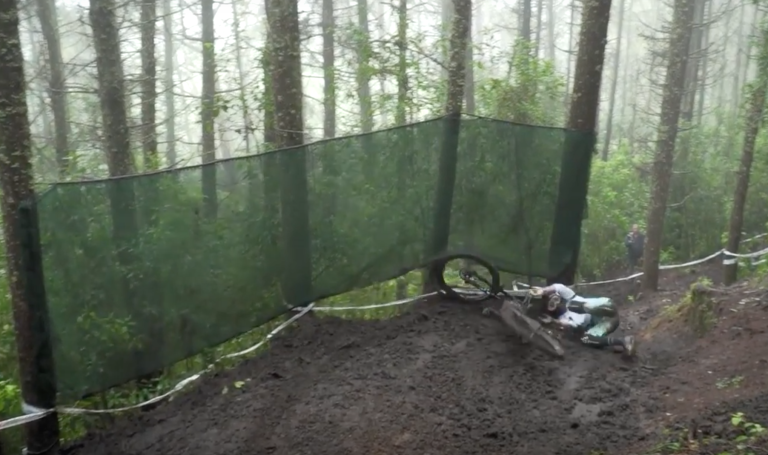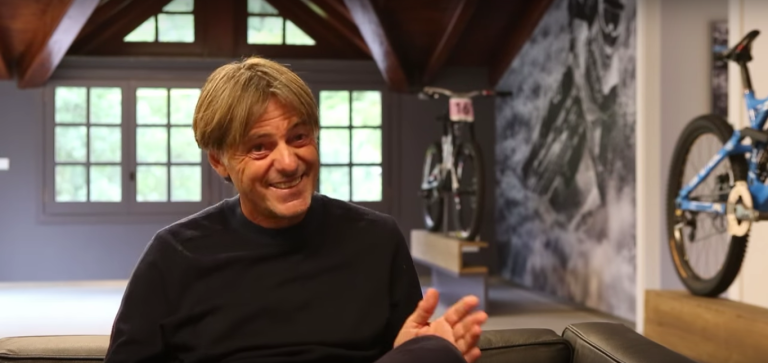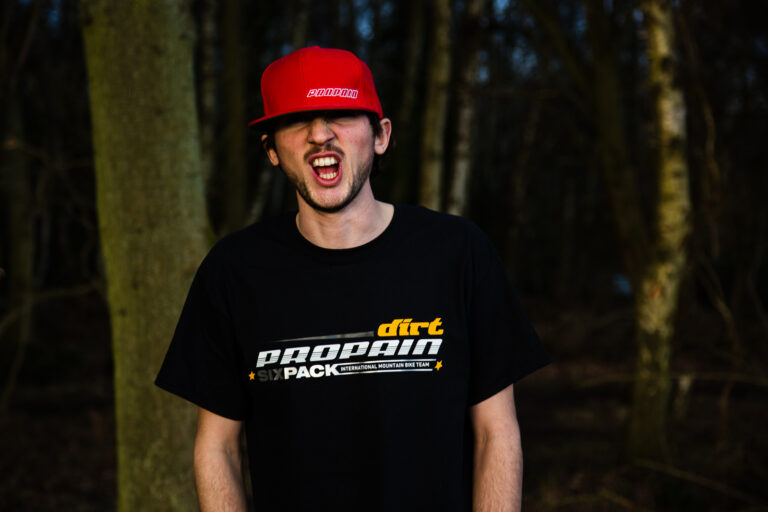
From Dirt Issue 138 – August 2013
Words by Steve Jones. Photos by Sven Martin, Sebastian Schieck, Victor Lucas and Steve Jones.
Featuring five European races, punctuated with a trip to North America mid–August and a showdown in Norway, the World Cup downhill season has already thrown up some stunners. Last year we were left with an Aaron Gwin legacy, the American having won nine of the previous fourteen events, he seemed to have an unassailable poise through the vast and varied landscapes that this series visits and all the rocks and high–speed mayhem in between.
He would have challengers in Greg Minnaar (obviously) and Gee Atherton, both powerful podium finishers; and others in Steve Smith, Brook Macdonald, Danny Hart, Loic Bruni, Josh Bryceland and Cam Cole… brilliant… yet all of whom have struggled to string together some form of consistency, let alone wins. Nevertheless, Brook and Stevie Smith had succeeded at the highest level in 2012, soaring to the heights and latitudes of Val d’Isere and Hafjell respectively. They were fully expected to bring some kind of battle to the new Specialized star for 2013.
By mid Saturday afternoon on June 8th at Fort William it became clear that something was up. Gwin was down, way down. Minnaar was not firing either. They left northern Britain with an ultimatum having only scraped into the top twenty and ten respectively. Gee Atherton was trucking on and it seems like nobody is going stop either him or his little sister Rachel. This then is the on–going drama of the 21st year of World Cup racing.>>
 Most should have seen this one coming. In 2010 Gee Atherton won the series on one of the heaviest bikes in the top twenty. In 2011 he switched bikes to a new design that he didn’t appear to be totally comfortable on, but nevertheless he achieved five podiums out of seven races. 2011 saw the move to GT dragging Marc Beaumont with them; or was that the other way around? Whatever, they settled well on the new bikes that had to be majorly modified to compete – something that Beaumont and mechanic Mark Maurisson had done the groundwork on. Gee podiumed every single race last season and, apart from Val di Sole, was never more than two seconds off the win. But these were what could be seen in the future as the ‘Gwin years’, the purple patch of American domination.
Most should have seen this one coming. In 2010 Gee Atherton won the series on one of the heaviest bikes in the top twenty. In 2011 he switched bikes to a new design that he didn’t appear to be totally comfortable on, but nevertheless he achieved five podiums out of seven races. 2011 saw the move to GT dragging Marc Beaumont with them; or was that the other way around? Whatever, they settled well on the new bikes that had to be majorly modified to compete – something that Beaumont and mechanic Mark Maurisson had done the groundwork on. Gee podiumed every single race last season and, apart from Val di Sole, was never more than two seconds off the win. But these were what could be seen in the future as the ‘Gwin years’, the purple patch of American domination.
Over the past five years Gee seems to have stolen ground from that most majestic of racers, Greg Minnaar, to achieve the highest podium percentages, 85.2% over the past five years. He is now a guy that wins races. This has taken almost a decade. Seven wins now since his first at Schladming back in 2004, and he’s been competing in World Cup’s for half their (WC) history.
What has allowed this to happen? The Atherton’s wintered well, riding hard tracks, long tracks, getting up to their necks in training, a well oiled race outfit with over a decade’s experience behind them. Crucially a new bike was made, and finally after many years they now had the machinery to compete within the hundredths of a second that separate a race win from the rest of the pack.
 Then there’s the incredible back up. There are syndicates and there are organizations. Lapierre even have a ‘gravity republic’ with a tent and van to rival the big GT juggernaut that is currently rolling. This squad comes so well drilled and is fashioned with bullets so well prepared it’s almost impossible to see any other result but success this season for Gee and Rachel.
Then there’s the incredible back up. There are syndicates and there are organizations. Lapierre even have a ‘gravity republic’ with a tent and van to rival the big GT juggernaut that is currently rolling. This squad comes so well drilled and is fashioned with bullets so well prepared it’s almost impossible to see any other result but success this season for Gee and Rachel.
It’s not only hardware and solid training that has got them this far. Take for example just one of the staff – in Piotr Michaliszyn they have a spannerman thirsty for knowledge, if not a shade obstinate when questioned on frame geometries on race day (they’ve worked their digits out correctly and the team are collectively now dishing out a fair old number on the opposition). It’s great to see Gee now riding a bike that fits him and the measuring doesn’t stop on the bikes, for every race Gee appears to be getting his chassis measured up by the body managers, just one part of a huge team of workers behind the scenes that go into delivering the top position on the podium. How long will it last? The comfort will grow and the pressure will drop with each and every race… they seem fully destined to win this.
[part title=”THE GWIN ULTIMATUM”]
 A man chasing his legacy, Aaron Gwin sauntered into Fort William off the pace and staggered out of there almost out of the points. It was a mighty fall for the man who has utterly dominated the past few seasons. A man of such high standing has never fallen so far in such a short space of time at this level. What were the reasons?
A man chasing his legacy, Aaron Gwin sauntered into Fort William off the pace and staggered out of there almost out of the points. It was a mighty fall for the man who has utterly dominated the past few seasons. A man of such high standing has never fallen so far in such a short space of time at this level. What were the reasons?
It was fully being expected that the world series would pick up where it left off, that Gwin would have wintered well, kept warm in the sunny Californian climate and re–emerged to regain full control. His four on the trot in 2012 scooped the series in no uncertain terms. This young star that had risen in the space of three years had established himself as one of the greatest downhill racers ever. He had learned to close down events, usually dominating both quali’s and finals.
Check for a minute the timescale. The season’s opener at Fort William was a month short of a full year since Gwin had his last win in Windham. A lot happened since that event. Injury, bike, tyres, team and manager changes, fallout from the move from Trek to Specialized – how had these affected his preparations?
There is a theory that Gwin actually went into free fall before the year began. He got injured at Val d’Isere, a mechanical at Leogang Worlds, another crash in Hafjell. Autumn saw internal troubles being spilled across the internet and the cut with Trek, a bike and team with whom he had gained major, major success with. The fall out was considerable. How much did that affect him?
The dust had settled. Gwin was picking away at his preparation for the season and he opened in grand fashion by winning Sea Otter. Whilst the rest of the World headed to Italian Riviera rocks, Gwin rocked up on a 29er Enduro and smoked them. Theory 2 – had wheel size changes affected his perception of speed?
 A third theory is one of risk. That Gwin had been in a constant search for equilibrium since his rapid rise and it come crashing down in Val d’Isere. And that, whereas the likes of Peaty and Minnaar come with a deeper understanding of flow and optimum speed, Gwin had, like Hill, been pushing outside the zone. Except that Gwin looked so, so composed during each of his wins when all others seemed to be in a sea of trouble. There appears to be no evidence to support this theory. Except he’d started crashing. How much had the injuries upset him?
A third theory is one of risk. That Gwin had been in a constant search for equilibrium since his rapid rise and it come crashing down in Val d’Isere. And that, whereas the likes of Peaty and Minnaar come with a deeper understanding of flow and optimum speed, Gwin had, like Hill, been pushing outside the zone. Except that Gwin looked so, so composed during each of his wins when all others seemed to be in a sea of trouble. There appears to be no evidence to support this theory. Except he’d started crashing. How much had the injuries upset him?
Another theory is that Gwin himself believed that he had an unassailable grip on world downhill. Complacency and confidence. Interrelated but worlds apart. How could a rider so far ahead fail to be anywhere else but at the top?
Gwin partly answered his critics in Val di Sole. Yes questions remained over his choice of bike and preparation. Why had the team turned up in Fort William without taking in some form of major winter training? Why had he not tried a range of sizes on the Specialized Demo? Why had he gone to a smaller bike with inherently less space and stability? Why had it taken him and the team until Val di Sole to discover this?
Was it a woman, had he got on the beer Kovarik/Rennie style? Was it food poisoning? Whatever, in Val di Sole having plummeted to some depth he made a remarkable turnaround to briefly lead the race. Swapping over to a large Demo with more space up front and began to arm wrestle the quali’s leading the first two splits before narrowly losing out to Gee by a second over the three minute course. A major improvement to the nine–second Fort William mauling. Gwin pulled out an almost identical final run time but it was not enough when the top ten had upped their game by on average three to four seconds. It was a very different story to the nine–second bruising he dished out last year.
That said he still remains one downhill’s most successful racers, but for downhill’s sake we all hope he’s not just the most fiercely burning star that’s ever been.





